Related Research Articles

Flavius Julius Constans, sometimes called Constans I, was Roman emperor from 337 to 350. He held the imperial rank of caesar from 333, and was the youngest son of Constantine the Great.

Constantine II was Roman emperor from 337 to 340. Son of Constantine the Great and co-emperor alongside his brothers, his attempt to exert his perceived rights of primogeniture led to his death in a failed invasion of Italy in 340.
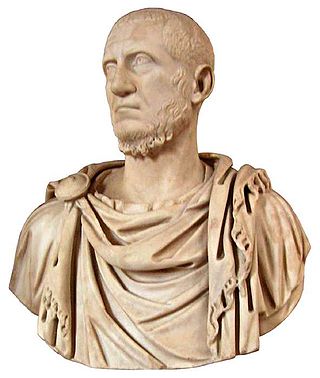
Marcus Claudius Tacitus was Roman emperor from 275 to 276. During his short reign he campaigned against the Goths and the Heruli, for which he received the title Gothicus Maximus.

Aurelian was a Roman emperor, who reigned during the Crisis of the Third Century, from 270 to 275. As emperor, he won an unprecedented series of military victories which reunited the Roman Empire after it had nearly disintegrated under the pressure of barbarian invasions and internal revolts. Born in modest circumstances, near the Danube River, he entered the Roman army in 235 and climbed up the ranks. He went on to lead the cavalry of the emperor Gallienus, until Gallienus' assassination in 268. Following that, Claudius Gothicus became emperor until his own death in 270. Claudius' brother Quintillus ruled the empire for three months, before Aurelian became emperor.
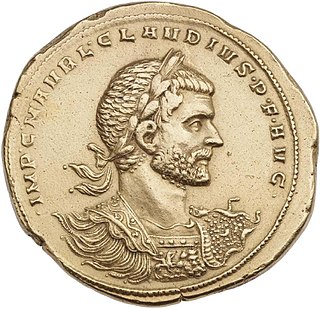
Marcus Aurelius Claudius "Gothicus", also known as Claudius II, was Roman emperor from 268 to 270. During his reign he fought successfully against the Alemanni and decisively defeated the Goths at the Battle of Naissus. He died after succumbing to a "pestilence", possibly the Plague of Cyprian that had ravaged the provinces of the Empire.

Flavius Valerius Constantius "Chlorus", also called Constantius I, was Roman emperor from 305 to 306. He was one of the four original members of the Tetrarchy established by Diocletian, first serving as caesar from 293 to 305 and then ruling as augustus until his death. Constantius was also father of Constantine the Great, the first Christian emperor of Rome. The nickname Chlorus was first popularized by Byzantine-era historians and not used during the emperor's lifetime. After his re-conquering of Roman Britain, he was given the title 'Redditor Lucis Aeternae', meaning 'The Restorer of Eternal Light'.

Marcus Aurelius Carinus was Roman emperor from 283 to 285. The elder son of emperor Carus, he was first appointed Caesar and in the beginning of 283, with the title of Augustus, he was appointed co-emperor of the western portion of the empire by his father. Official accounts of his character and career, which portray him as debauched and incapable, have been filtered through the propaganda of his successful opponent, Diocletian.
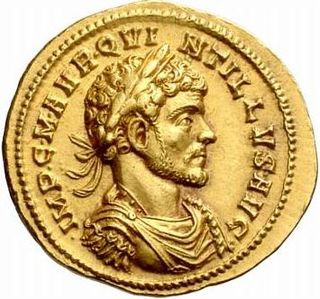
Marcus Aurelius Claudius Quintillus was a Roman emperor. He was a brother of Emperor Claudius Gothicus, whom he succeeded after Claudius' death in 270. Quintillus' claim to be emperor was challenged by Aurelian, who was proclaimed emperor by the legions he commanded. Quintillus' reign lasted no more than six months. Different sources report his cause of death as murder by his own soldiers, in battle with Aurelian, or by suicide.

Flavius Julius Crispus was the eldest son of the Roman emperor Constantine I, as well as his junior colleague (caesar) from March 317 until his execution by his father in 326. The grandson of the augustus Constantius I, Crispus was the elder half-brother of the future augustus Constantine II and became co-caesar with him and with his cousin Licinius II at Serdica, part of the settlement ending the Cibalensean War between Constantine and his father's rival Licinius I. Crispus ruled from Augusta Treverorum (Trier) in Roman Gaul between 318 and 323 and defeated the navy of Licinius I at the Battle of the Hellespont in 324, which with the land Battle of Chrysopolis won by Constantine forced the resignation of Licinius and his son, leaving Constantine the sole augustus and the Constantinian dynasty in control of the entire empire. It is unclear what was legal status of the relationship Crispus's mother Minervina had with Constantine; Crispus may have been an illegitimate son.

The Historia Augusta is a late Roman collection of biographies, written in Latin, of the Roman emperors, their junior colleagues, designated heirs and usurpers from 117 to 284. Supposedly modeled on the similar work of Suetonius, The Twelve Caesars, it presents itself as a compilation of works by six different authors, written during the reigns of Diocletian and Constantine I and addressed to those emperors or other important personages in Ancient Rome. The collection, as extant, comprises thirty biographies, most of which contain the life of a single emperor, but some include a group of two or more, grouped together merely because these emperors were either similar or contemporaneous.

Flavia Maximiana Theodora was a Roman empress, wife of Constantius Chlorus.

Marcus Piavonius Victorinus was emperor in the Gallic provinces from 268 to 270 or 269 to 271, following the brief reign of Marius. He was murdered by a jealous husband whose wife he had tried to seduce.
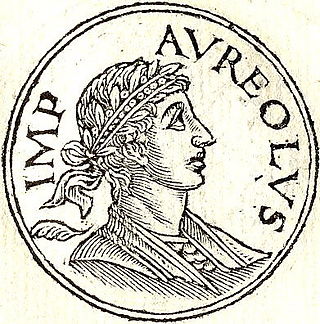
Aureolus was a Roman military commander during the reign of Emperor Gallienus before he attempted to usurp the Roman Empire. After turning against Gallienus, Aureolus was killed during the political turmoil that surrounded the Emperor's assassination in a conspiracy orchestrated by his senior officers. Aureolus is known as one of the Thirty Tyrants and is referenced in ancient sources including the Historia Augusta, Zonaras' epitome and Zosimus' Historia Nova.
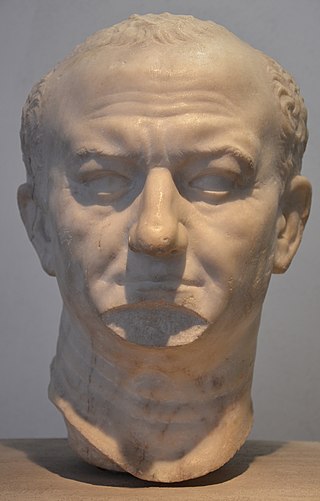
The gens Flavia was a plebeian family at ancient Rome. Its members are first mentioned during the last three centuries of the Republic. The first of the Flavii to achieve prominence was Marcus Flavius, tribune of the plebs in 327 and 323 BC; however, no Flavius attained the consulship until Gaius Flavius Fimbria in 104 BC. The gens became illustrious during the first century AD, when the family of the Flavii Sabini claimed the imperial dignity.

Priestess of Avalon is a 2000 novel by American writer Marion Zimmer Bradley, completed posthumously by Diana L. Paxson. It follows detailing the life of Helena, first wife of Western Roman Emperor Constantius Chlorus and mother of Constantine.
(Flavius) Julius Constantius was a politician of the Roman Empire and a member of the Constantinian dynasty, being a son of Emperor Constantius Chlorus and his second wife Flavia Maximiana Theodora, a younger half-brother of Emperor Constantine the Great and the father of Emperor Julian.

The Illyriciani or Illyrian emperors were a group of Roman emperors during the Crisis of the Third Century who hailed from the region of Illyricum, and were raised chiefly from the ranks of the Roman army. In the 2nd and 3rd centuries, the Illyricum and the other Danubian provinces held the largest concentration of Roman forces, and were a major recruiting ground. The advance of these low-born provincials was facilitated by a major shift in imperial policy from the time of Gallienus (253–268) on, when higher military appointments ceased to be exclusively filled by senators. Instead, professional soldiers of humble origin who had risen through the ranks to the post of primus pilus were placed as heads of the legions and filled the army's command structure.

The Constantinian dynasty is an informal name for the ruling family of the Roman Empire from Constantius Chlorus to the death of Julian in 363. It is named after its most famous member, Constantine the Great, who became the sole ruler of the empire in 324. The dynasty is also called Neo-Flavian because every Constantinian emperor bore the name Flavius, similarly to the rulers of the first Flavian dynasty in the 1st century.

The German and Sarmatian campaigns of Constantine were fought by the Roman Emperor Constantine I against the neighbouring Germanic peoples, including the Franks, Alemanni and Goths, as well as the Sarmatian Iazyges, along the whole Roman northern defensive system to protect the empire's borders, between 306 and 336.

The Battle of Brescia was a confrontation that took place during the summer of 312, between the Roman emperors Constantine the Great and Maxentius in the town of Brescia, in northern Italy. Maxentius declared war on Constantine on the grounds that he wanted to avenge the death of his father Maximian, who had committed suicide after being defeated by him. Constantine would respond with a massive invasion of Italy.
References
- 1 2 Syme, Ronald (1983). Historia Augusta Papers. Clarendon. p. 71. ISBN 9780198148531.
- 1 2 Hekster, Olivier (2015). Emperors and Ancestors: Roman Rulers and the Constraints of Tradition. Oxford Studies in Ancient Culture & Representation. OUP Oxford. p. 225. ISBN 9780191056550.
- ↑ Jovanović, Aleksandar (2006). Тло Србије: завичај римских царева. Princip-Bonart Pres. p. 126. ISBN 9788685215100.
- ↑ Cameron, Averil; Hall, Stuart (1999). Eusebius' Life of Constantine. Clarendon Press. p. 201. ISBN 9780191588471.
- ↑ Southern, Patricia (2015). The Roman Empire from Severus to Constantine (second, reworked ed.). Routledge. ISBN 9781317496939.
- ↑ Lieu, Samuel; Montserrat, Dominic (2002). From Constantine to Julian: Pagan and Byzantine Views: A Source History. Routledge. pp. 68–69. ISBN 9781134871186.
- ↑ Doležal, Stanislav (January 2020). "Two of Constantine's "official lies"". Graeco-Latina Brunensia: 65 – via ResearchGate.
- ↑ Bullough, Vern L.; Bullough, Bonnie (1978). Prostitution: An Illustrated Social History. Crown Publishers. p. 51.
- ↑ Drinkwater, J. F. (1987). The Gallic Empire: Separatism and Continuity in the North-western Provinces of the Roman Empire, A.D. 260-274. Coronet Books. p. 64. ISBN 9783515048064.
- ↑ Harries, Jill (2012). "8: The sons of Constantine". Imperial Rome AD 284 to 363. Edinburgh University Press. ISBN 9780748653959.
- ↑ Shahîd, Irfan (1984). Rome and the Arabs: A Prolegomenon to the Study of Byzantium and the Arabs (illustrated ed.). Dumbarton Oaks. p. 84. ISBN 9780884021155.
- ↑ Belkin, Kristin Lohse; Healy, Fiona; Muller, Jeffrey M. (2004). A House of Art: Rubens as Collector: Rubenshuis & Rubenianum. BAI. p. 282. ISBN 9789076704692.
- ↑ Historia. Historia: Zeitschrift Für Alte Geschichte. Vol. 33. F. Steiner. 1950. p. 97.
- ↑ Drijvers, Jan Willem (1992). Helena Augusta. BRILL. p. 193. ISBN 9789004094352.
- 1 2 Bulletin van de Vereeniging tot Bevordering der Kennis van de Antieke Beschaving. Archaeologisch Instituut. 1965. p. 93.
- ↑ Smith, R. R. R. (14 July 2021). "Maiestas Serena: Roman Court Cameos and Early Imperial Poetry and Panegyric". The Journal of Roman Studies. Cambridge University Press. 111: 75–152. doi:10.1017/S0075435821000459. S2CID 237800530 – via Cambridge.org.